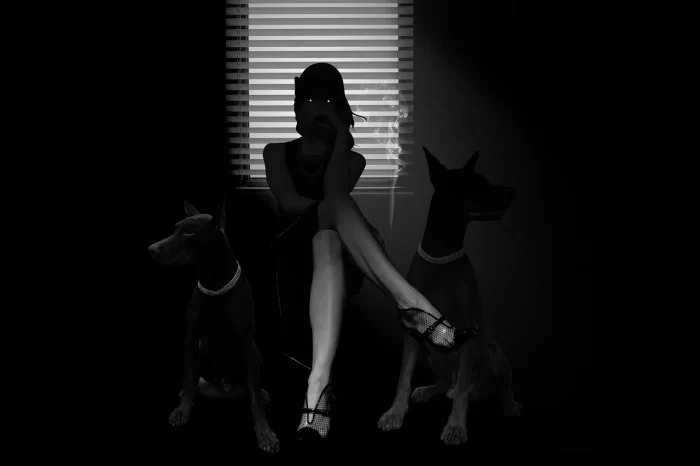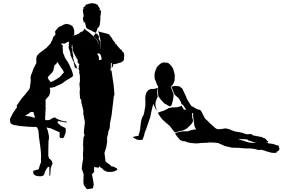The first step to developing your creative writing is to create the characters. Character archetypes are a way of categorizing all types of character, and they can be broken down into three categories: main, supportive, and minor. Each type has its own set of characteristics that help define it as an archetype.
-The main characters are the protagonist or hero of the story who is always in the spotlight. They have goals that they want to accomplish by the end of the story.
-The supporting characters help our main characters with their own goals, which may not align with the protagonists.
– The minor characters usually only appear once or twice throughout a text and do not significantly impact either side.
This blog post will talk about eight different types of cut-throat characters for you to use in your creative writing!
1. The femme fatale – a woman who uses her beauty and sexuality to manipulate men
A femme fatale uses her beauty and sexuality to manipulate men, often leading them into dangerous situations. She is a mysterious woman who usually has an ulterior motive for getting involved with the protagonist in some way or another.
The Femme Fatale archetype can be very useful when creating characters that you know little about their motivations and backstories – it allows you to use the femme fatale to explain any holes in the story. It can make for an interesting character, especially if you reveal her backstory later on.
A great example of this is Black Widow from The Avengers (2012) – The black widow uses her beauty and sexuality to get close enough to learn about their plans before destroying them herself!
Sharon Stone portrays other famous Femme Fatales in Basic Instinct, Faye Dunaway in Chinatown, and Rita Hayworth in Gilda.
2. The villain – a person who is the cause of all the troubles in your novel
The villain is the perfect example of a stock character – they are familiar tropes in fiction to make stories more interesting! Villains can range from the evil witch in fairy tales to science gone wrong like Frankenstein’s monster.
Memorable villains must be staggeringly powerful. They are clever enough to avoid making stupid decisions. They often subscribe to a moral code, but they are willing to violate accepted moral principles in order to achieve their goals. What separates the great villains from the lesser baddies is that a truly formidable villain is possessed by an unstoppable drive to achieve their goal.
Apart from their psychological wounds, villains are usually wounded, manifesting as physical wounds or disfigurements, reflecting the great truth that no human being is born a monster. Something must have happened to transform an innocent child into a homicidal adult.
Use the villain archetype when you want your characters to face something they cannot defeat.
Here are a few examples:
-Darth Vader from Star Wars (1977). He has no backstory or development in the film – he shows up on the screen as an evil guy with some impressive powers! However, when we discover his history in episodes later in the franchise, we see that he is not quite as evil as thought initially.
-The Joker gained renewed popularity after being portrayed by Heath Ledger in 2008’s The Dark Knight. But, unfortunately, we know nothing about his inner-psychology beyond obvious sociopathic tendencies and can barely figure out his real motives beyond an odd devotion to maintaining Batman’s attention.
-Robert Patrick, thought of as “one of the great heavies” in the film industry, left a deep impression playing T-1000, the cunning metal killer in Terminator 2: Judgement Day (1991).
-Anthony Hopkins horrified viewers with his portrayal of Hannibal Lecter, a psychopathic serial killer, and former psychiatrist, in The Silence of the Lambs.
3. The nemesis/challenger
The nemesis character usually challenges the protagonist and may even help them grow as a character.
You can use this archetype for various intensity levels: from friendly banter between friends (for example, to hate the protagonist’s attention) to a bitter, personal disliking. They can be as pushy as they like – the protagonist is required to step up and respond!
The nemesis character should not be confused with the antagonist character – they are very different! Although sometimes it may seem like there is no difference between them, it depends on the intensity of their relationship.
Antagonists create obstacles for the protagonist. They may even have the protagonist’s best interests at heart but acts to thwart the protagonist’s actions.
A nemesis is working against the protagonist because the two are completely at odds in their world views and purposes. A nemesis will never have the protagonist’s best interests in mind.
-There are different levels to this archetype – they can be friendly rivals (such as Elizabeth Bennet and Mr. Darcy in Pride and Prejudice), an anonymous change-maker you don’t find out about until later in the story.
Sherlock Holmes, for example, does not have an enemy per see, but Professor Moriarty certainly acts as one throughout many of Sir Arthur Conan Doyle’s famous stories. Unfortunately, in those cases where there is no explanation for his antagonism, the nemesis character is not developed well.
On the other hand, Harry Potter has a powerful archenemy in Voldemort. He attempts to murder Harry but instead kills his parents and leaves Harry with a scar on his head in the shape of a lightning bolt.
4. The sidekick character
The sidekick character is the best friend or someone on the protagonist’s side – but not quite as good.
This character type can be helpful to introduce into your story if there are already a lot of characters involved because it helps you distinguish between them more easily. The sidekick character tends to have fewer distinguishing features than other stock characters.
Even though they should contrast, you need to have a sidekick and a compatible protagonist. The sidekick is the protagonist’s immediate support, and they should be capable of forming a friendship.
There are four main sidekick archetypes:
The Muscles – like Chewbacca in Star Wars, are using their strength to fight or scare away the protagonist’s opponents.
The Brains – like Hermione Granger in Harry Potter, use their resourcefulness to solve problems most of the time.
The Humanizer – like Dr. Watson in Sherlock Holmes, humanizes Holmes, making him more relatable and likable.
The Friend – like Friday in Robinson Crusoe, is often loyal to a fault, the epitome of the reliable companion.
5. The lothario – a man with many sexual conquests
A lothario is a man who is irreverent, confident and uses his sexuality to manipulate women.
The character of lothario is a familiar archetype in literature, film, and television. Unfortunately, there is no explanation for why the ladies fall at his feet – it seems like magic, which can make him come across as more shallow than he deserves, but he’s still a fun character.
Examples:
In The Country Wife, Horner, the protagonist of William Wycherley’s Restoration comedy, spreads the (false) news that a disastrous treatment for venereal disease has left him impotent. Gleeful but gullible husbands are then happy for him to keep company with their wives, with predictable consequences. The plot was adapted for the film Shampoo, with Warren Beatty.
James Bond is the modern-day definition of a lothario. He may busy himself as a spy by day, saving the world from one disaster after another, but James always finds time to get the girl.
Alfie (Jude Law) is the quintessential British lady’s man. Between his devilish good looks, accent, and charm, the ladies cannot resist him, and he indeed uses that to his full advantage.
Giacomo Casanova (Heath Ledger), the man whose womanizing ways are so well known they have become synonymous with his very name.
6. The vigilante – an individual who takes justice into their own hands
The vigilante character is usually motivated by revenge for some personal loss. Still, they can also believe that there’s just too much crime and corruption in society, so someone must do something! They do this to restore order in the world according to their moral code. This archetype has appeared throughout history, from classical literature like Robin Hood through modern pop culture.
Examples:
In Taxi Driver, a film by Martin Scorsese starring Robert De Niro and Jodie Foster. Set in a decaying and morally bankrupt New York City following the Vietnam war, the film follows Travis Bickle (De Niro), a taxi driver and veteran, and his deteriorating mental state as he works nights in the city. The film was a critical and commercial success, despite generating controversy for its graphic violence at the ending and casting of then-12-year-old Foster in the role of a child prostitute.
Cape Fear, another Scorsese film, tells the story of a convicted rapist who, primarily by using his newfound knowledge of the law and its loopholes, seeks vengeance against a former public defender. The rapist blames the defender for his 14-year imprisonment because of the faulty defense tactics used during his trial.
Hard Candy is an American psychological thriller film focusing on a 14-year-old female vigilante’s trapping and torture of a man she suspects is a sexual predator. The film received many film festival awards and made over $8 million at the box office.
7. The antihero – someone that has been dealt a bad hand but doesn’t let it stop them from being successful
An antihero is character-driven by pursuing power, sex, money, and control. Because of this, they are often selfish, anti-social, power-hungry, and materialistic.
An antihero is not your typical hero because he doesn’t always possess purely good qualities or personality traits. For example, while a hero is courageous in the face of battle, an antihero might be afraid.
Antiheroes have appeared in literature, in film, and on stage for centuries. While the antihero is flawed, he has evolved beyond the heroes from Shakespeare’s famous tragedies. That’s because the antihero’s flaws don’t always lead to his demise. Instead, they can help him achieve victory and even redemption.
Examples of antiheroes could be Alex from A Clockwork Orange, a thoroughly despicable character throughout most of the film; you feel a certain sense of vindication once Alex, guilty of an assortment of distasteful crimes, is eventually caught by the police.
Or Becky Sharp from Vanity Fair. Beautiful, charming, and clever, she has it all – except wealth. Her poverty acting as a constant lodestone in a society that prioritizes social status above all, Becky manipulates her way to the top – ruthlessly disposing of all who obstruct her.
Or Robert Lovelace from Clarissa. Lovelace played to perfection the role of the immoral villain, acting as a foil to Clarissa’s irreproachable virtue. A hedonist used to have his every desire gratified instantly; there was little Lovelace did not do in his increasingly desperate attempts to seduce Clarissa.
8. The manipulative one
A manipulative character is a character that is all about their agenda and will work to achieve it at any cost. They are master manipulators, using people’s emotions against them or twisting the truth to get what they want.
Usually, manipulators have two goals. They want to trust, and they want absolute control. Manipulative characters may let the other person speak first and ask questions to assess that person’s weaknesses. Other signs of manipulation include overwhelming someone with facts or procedures, raising one’s voice to get what they want, or playing dumb.
There is no line that this character will not cross. They don’t care about anyone but themselves, and they are willing to sacrifice others for their own ends.
The manipulative character doesn’t always win in the end, but make no mistake – they will do anything it takes to get what they want.
Examples:
In Catch Me If You Can, Steven Spielberg tells the true story of Frank Abagnale, Jr. (Leonardo DiCaprio), a con man who bilked millions of dollars before the age of 20 writing fake checks. There was no one that Frank could not con.
Aaron Stampler in Primal Fear. How could this young, sweet, bumbling, simple altar boy possibly kill a priest in cold blood? Ed Norton wowed audiences with his big-screen debut as Stampler, convincing a court of law, his lawyer, and every audience member of his innocence.
In The Talented Mr. Ripley, Tom Ripley (Matt Damon) is truly a wolf in sheep’s clothing. Sure, he looks sweet and innocent, but he is a blue-collar kid who dreams of a rich life and won’t stop at murder to get it.
In Cruel Intentions, rich prep teen Kathryn Merteuil (Sarah Michelle Gellar) makes a wager by seduction with her stepbrother Sebastian. She manipulates Annette and Cecil’s innocence by pretending to be their friend and owns Sebastian through her seductive machinations.
Conclusion
Have some fun with your character creation! If you think of different character archetypes, try to pick one and write an interesting story about it.
Character development is vital in every novel and can make all the difference in your book. Character archetypes are just one of the many tools writers can use to bring their work to life while keeping readers entertained and wanting more!
Don’t hesitate to make your special characters a bit outrageous 🙂
If you’re working on your first novel and are looking for more help with your writing, please check out my other articles at https://ullahakanson.com/blog/
Best of luck with your writing!
Ulla




